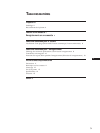
GBGB
Additional Information
15
EN
Glossary
ATS
Automatic Tape Selection. The tape deck automatically sets
the appropriate equalization characteristics and bias current
according to the tape type inserted in the deck.
Bias calibration
Adjustment for optimum recording. You can get better
recording results with minimum distortion and flat
frequency response by adjusting the bias current to the
appropriate level. Lowering the bias current can boost high-
frequency response, but also cause higher distortion. On the
other hand, raising the bias current can minimize distortion,
but also reduce high-frequency response. To balance both
the bias current and high-frequency response, it is necessary
to adjust the bias current appropriately.
However, to suit your taste, you can also adjust the bias
current as you want.
Output
level
Dolby HX PRO system
Distortion and noise reduction system. The Dolby HX PRO
system reduces distortion and noise in high-frequency
response while recording. A tape recorded with this system
brings the same high-quality sound even when you play the
tape on the other tape decks.
Dolby NR (noise reduction) system
Noise reduction system for eliminating hissing noise. The
Dolby NR system boosts the low-level signals in high
frequency during recording and restores them during
playback.
There are 4 types in the Dolby NR system: A, B, C and S.
A-type is for professional use (not available on this tape
deck), and B, C and S-types are for consumer use. S-type has
the maximum noise reduction capability, followed by C and
B.
noise reduction
Dolby
NR off
Output
level
MPX filter
Multiplex filter. A filter for eliminating the 19-kHz stereo
carrier and the 38-kHz sub-carrier signals that may impair
the Dolby NR system. Usually the tuner has an MPX filter.
If you cannot get a satisfying result when recording FM
broadcasts with Dolby NR system, your tuner does not have
a filter or the filter is not working. In this case, turn the
DOLBY NR switch countercolckwise to the position you
want (B, C, or S with MPX FILTER).
Multi-AMS
Multi-Automatic Music Sensor is a function that locates the
beginning of up to 30 tracks before or after the current track
by detecting a blank space (of over 4 seconds) between
tracks.
Recording level calibration
Adjustment for optimum recording. Even when you have
adjusted the recording level correctly, the playing level
might turn out to be low depending on the tape used. By
adjusting the recording level calibration, you can
compensate for the low recording level. When you record
on a tape with the Dolby NR system, this function works
more effectively.
Tape counter
A display element that shows the elapsed recording or
playing time as a digital readout. Since the counter is not a
digital clock, the displayed value will differ slightly from the
actual elapsed recording or playing time. The counter value
also includes the length of the leader tape.
Test tones
10-kHz and 400-Hz signals produced by the tape deck when
you do the bias and recording level calibration.
Output
level
dB
Hz
+
0
–
400 3k
15k
B
C
S
Hz
dB
1k
5k
100 500 10k
dB
Hz
+
0
–
400 3k
15k


















